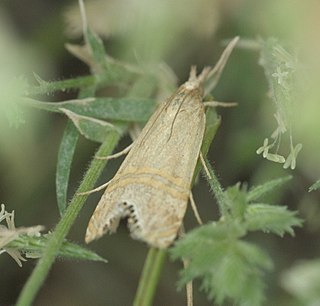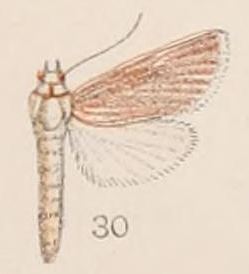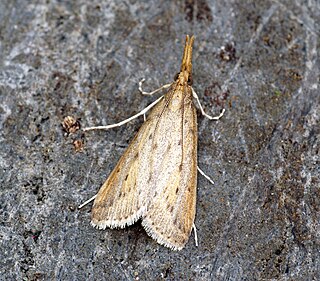
Euchromius is a genus of moths of the family Crambidae. It was described by Achille Guenée in 1845.
Hoploscopa is a genus of snout moths in the subfamily Hoploscopinae of the family Crambidae. The genus was described by Edward Meyrick in 1886, with Hoploscopa astrapias as type species.

Lamprosema is a genus of moths of the family Crambidae described by Jacob Hübner in 1823.
Megastes is a genus of moths of the family Crambidae.
Mimudea is a genus of moths of the family Crambidae described by William Warren in 1892.

Patissa is a genus of moths of the family Crambidae erected by Frederic Moore in 1886.

Sufetula is a genus of moths of the family Crambidae.

Scirpophaga is a genus of moths of the family Crambidae described by Georg Friedrich Treitschke in 1832. Asian species include significant rice stemborer pests.

Scirpophaga incertulas, the yellow stem borer or rice yellow stem borer, is a species of moth of the family Crambidae. It was described by Francis Walker in 1863. It is found in Afghanistan, Nepal, north-eastern India, Sri Lanka, Bangladesh, Myanmar, Vietnam, Thailand, Malaysia, Singapore, Sumatra, Java, Borneo, Sumba, Sulawesi, the Philippines, Taiwan, China and Japan.

Schoenobiinae is a subfamily of the lepidopteran family Crambidae. The subfamily was described by Philogène Auguste Joseph Duponchel in 1846.
Euchromius brunnealis is a moth in the family Crambidae. It was described by George Hampson in 1919. It is found in the Philippines.
Scirpophaga terrella is a moth in the family Crambidae. It is found in Paraná, Brazil.
Scirpophaga auristrigellus is a moth in the family Crambidae. It was described by George Hampson in 1896. It is found in Guangxi, China, India and Bhutan.
Scirpophaga aurivena is a moth in the family Crambidae. It was described by George Hampson in 1903. It is found in the Khasi Hills of north-eastern India.
Scirpophaga flavidorsalis is a moth in the family Crambidae. It was described by George Hampson in 1919. It is found in Yunnan, China, India, Bhutan, Bangladesh, Thailand, western Malaysia, Java, the Philippines, New Guinea and Australia.
Scirpophaga fusciflua is a moth in the family Crambidae. It was described by George Hampson in 1893. It is found in Taiwan, Afghanistan, India, Nepal, Thailand and Sri Lanka.
Scirpophaga ochritinctalis is a moth in the family Crambidae. It was described by George Hampson in 1919. It is found in Angola, the Central African Republic, the Democratic Republic of the Congo, Ghana, Malawi, Nigeria, Sierra Leone, Tanzania, Uganda and Zambia.
Herpetogramma brunnealis is a moth in the family Crambidae. It was described by George Hampson in 1913. It is found on Mayotte and Réunion and in Ghana, Madagascar and Nigeria.
Sufetula brunnealis is a moth in the family Crambidae. It was described by George Hampson in 1917. It is found in the Philippines.




